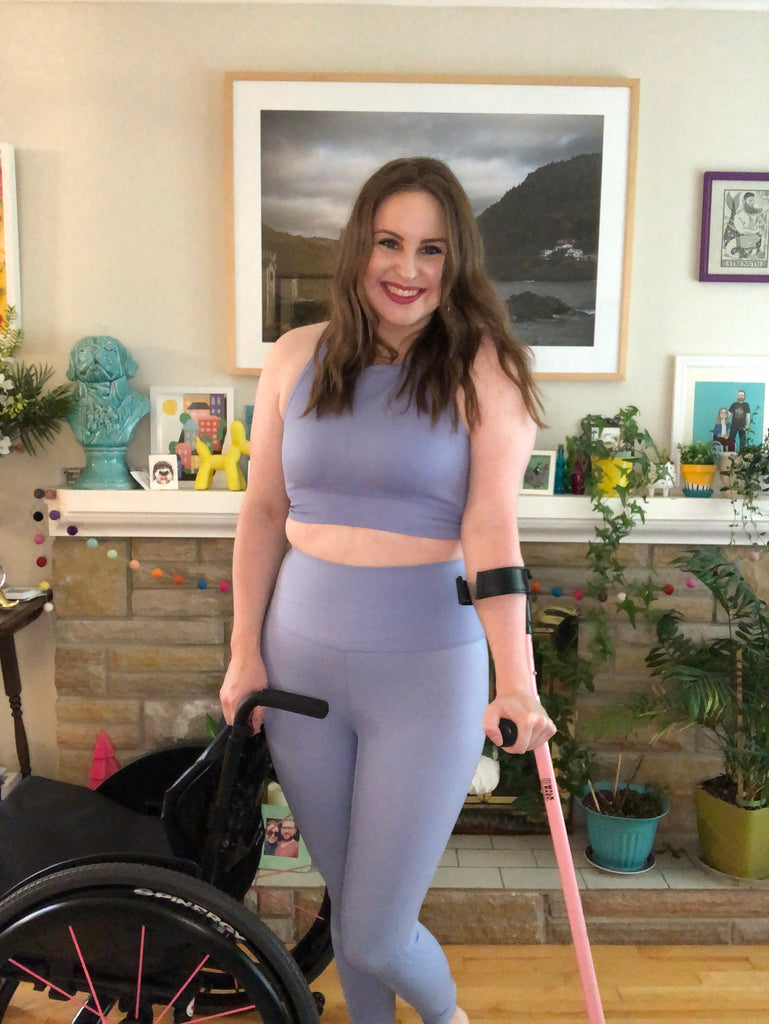Moving Through the World as a Full-Time Wheelchair User
The way that I move through the world has changed a lot over the last few years. I used to be someone who walked everywhere, went for morning runs on occasion, and didn’t have to think about how I would get from one place to the next. My body just did the things I expected it to do. That has recently changed for me though.
After a few years of my body slowing down and a growing list of injuries, I was diagnosed with hypermobile Ehlers-Danlos Syndrome. I call it hEDS for short, and it’s a genetic connective tissue disorder that doesn’t allow my collagen to work properly. Collagen is basically the glue that holds your joints, tendons, muscles (and everything) together. It can cause joint dislocations, muscle weakness and pain, fatigue, and a host of other things. Thanks to my faulty glue, I am now a full-time wheelchair user— although I can get around very short distances with the help of my leg braces and crutches.
Now, moving through the world is something that I have to think about all of the time, because the world isn’t built with this new version of my body in mind. As a disabled woman who is still learning to navigate this world on wheels and with a body that is constantly changing, there are some things I wish I knew beforehand. Here are some of them:
Movement looks different for everyone, and there’s no right way to do it.
When I first realized that I had a disability, the only thing that really mattered to me and to some people on my medical team was for me to keep walking. For a long time it was the main goal. “Keep walking, no matter what.” When I started using a cane it sort of felt like failing because walking unaided was being placed on such a high pedestal for me.
 Lisa is wearing the Good to Go Hoodie and HiTouch HighRise Legging
Lisa is wearing the Good to Go Hoodie and HiTouch HighRise Legging
When I finally got my hEDS diagnosis we realized that forcing my body to over-exert itself was very detrimental to my long-term health, and we started to focus on my quality of life rather than ensuring I move through it without help. I started using crutches, then a rollator and now a wheelchair. I began moving through the world in a way that caused me less pain and exhaustion, and allowed me to enjoy myself way more. Everyone is different and walking shouldn’t be seen as the “best” way to get around. There is no “best” way, and it’s okay to rely on tools to help you move. It’s also okay if you need to constantly switch up how you move. Maybe sometimes you can walk and maybe sometimes you need to roll. Do what feels right for you.
Rest is good and needing it doesn’t make you a failure.
Everyone has to move at their own pace. It’s important to listen to your body and not to work against what it wants. For some people, pushing through the pain and discomfort to keep moving is okay. For others, it can cause a lot of problems. We live in a society that values the “grind” and “hustle” but not one that values resting. It took me a long time to realize that I am still just as valuable as the next person, even if I have to rest when they can keep going. Bodies that aren't always on the move are still good bodies. You shouldn’t feel guilty when you need to take it slow.

The world isn’t built for disabled bodies, and we need to change that.
When I was an able-bodied person I barely registered the built environment around me. Not many things were considered obstacles to me because I could just jump over them and continue on with my day. Once I started using mobility aids I finally realized how inaccessible the world around me was. I’ve only been using a wheelchair for less than two years now and I’m still shocked regularly by the amount of places that I can’t get to.
Spontaneously moving through my city is no longer a reality for me. I have to plan ahead, think through my routes, call or Google businesses before going there to see if I can get in, pick places based on parking and how good the sidewalks are for wheelchair users. It’s a lot for me, and I have privileges that some disabled people don’t have (like access to a car). I now understand that movement is often stifled for disabled people because of our society and not because of our disabilities. I wish I had recognized these issues and paid more attention to them before it impacted me directly. We need more non-disabled people to notice these barriers and to help us address them so we can have the same access to the world as everyone else.
As someone with a disability that has been steadily progressing over the last few years, the way that I move is constantly changing. Some days it feels like hard work to love my body and how it moves (accepting the muscle spasticity and weakness is a process) but there are plenty of days when it comes more easily and I am proud of my progress. My relationship with the world that I’m moving through is changing too, but I’m slowly figuring it all out. It’s certainly a learning experience.
Cover Image by: @vanessa_iddon








